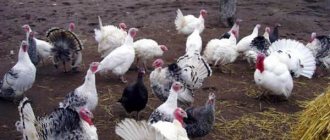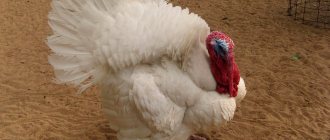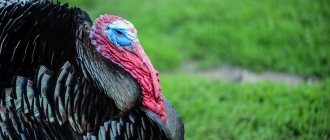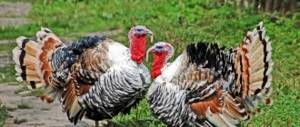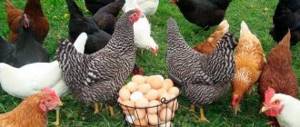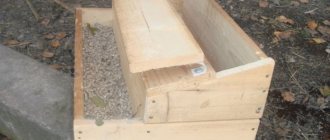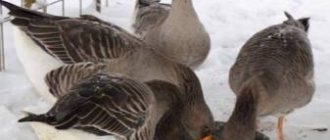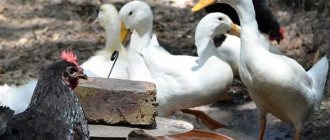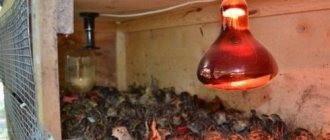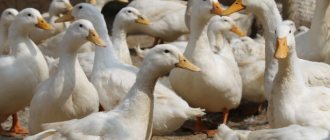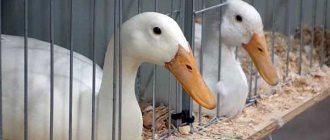A little bit of history
In many developed countries, turkey meat is one of the main decorations of the holiday table. It is used not only for preparing single dishes, but is also part of incredibly tasty smoked meats. For large feasts, a chicken carcass will not be enough, but a 20-kilogram overseas bird will be enough for everyone.
Turkeys already had more than 1,000 years of domestic experience behind them by the time they arrived on the European continent along with the ship of Christopher Columbus.
Turkeys were brought to Europe thanks to the efforts of Christopher Columbus.
Turkeys are considered large poultry: males easily gain 20 kg, and females - 10 kg or even more. Differences in weight are observed already after reaching 20 days: males are approximately 30% heavier than females. By the 4th month, the weight of the bird begins to increase rapidly: in females the weight indicator increases by 170 times, and in males by 200 times. If we transfer this phenomenon to a person, then at 4 months he would weigh 700 kg.
Tips and tricks for beginners
Keeping turkeys at home for beginners begins with purchasing turkey poults.
- Don't buy small turkeys. Take an older bird.
- Their maintenance and cultivation provides a good income and every person can do it.
- Never place even grown turkey poults with other poultry.
- At an early age, pay special attention to feeding, water quality and temperature conditions.
- Keep the recommended number of individuals indoors, which can be divided by age category.
- Sensitivity to diseases makes it necessary to monitor the cleanliness of feeders and drinking water. Requires periodic disinfection of the premises.
- Prone to obesity. Therefore, a balanced diet and walking in the fresh air are required.
- Tend to fly. If necessary, you need to trim the wings.
- If you are planning to grow for business, then you need to draw up a business plan and carefully read the requirements and recommendations for maintenance and care.
Preparing for winter
A good owner prepares for winter from the beginning of summer. The fact is that in winter turkeys need a comfortable, spacious room. An old chicken coop can accommodate several birds, but if you have a large flock, it is better to build a separate poultry house for it. During construction, at least a square area of area must be allocated for each bird . In the summer, for comfortable keeping of domestic turkeys, the main thing is to have an extensive range, and in winter, the birds should have enough space in the house.
You need to think in advance about how to heat the room in winter. There are two types of heating for poultry houses:
- Natural heating, when the room temperature is maintained in winter by retaining heat. To achieve this effect, the owner must caulk all openings, except for the ventilation one, and insulate the walls at the stage of building the room. However, in very severe frosts, this method does not fulfill its purpose, and the room must be heated additionally.
- Artificial heating, for which electrical appliances, gas boilers, stoves, infrared appliances or lamps are used.
If the owner has not approached heating issues in advance, then the living conditions may not be comfortable enough and the turkeys will get sick or die.
Winter conditions
Poultry houses are built for turkeys, greenhouses and greenhouses are equipped. The main thing is that they are warm. If the winter in the region is not characterized by severe frosts, then it is enough to equip the turkey poultry with moisture-proofing material and insulation. In severe frosts, heaters are installed in the poultry house or a heating system is thought out:
- In greenhouses, pipes are laid underground through which hot water is released. Heating is usually provided for growing crops, but it is also well suited for turkeys. To prevent condensation from forming on the walls, the greenhouse is additionally insulated with basalt wool mats;
- lamps with ultraviolet or infrared radiation are installed in the poultry house for heating. IR lamps are protected with a metal grill. They are fixed on the ceiling so that individuals cannot reach them. Otherwise, the birds may suffer severe burns;
- If necessary, the room is heated with heat guns. Heating will be effective;
- in cold regions, pipes are installed in turkey poultry houses and radiators are installed: water or steam heating is used. Protection is installed on the equipment to prevent turkeys from reaching it. The water boiler is taken outside the poultry house.
The optimal temperature in a turkey house is 15 C. Some poultry farmers keep their livestock at sub-zero temperatures. This is explained by the fact that when heated, moisture can settle on the walls of the poultry house, which will lead to the development of rot and fungus. To prevent this from happening, it is recommended to consider ventilation and thermal insulation of the room. The optimal humidity for turkeys in winter is 55%.
If farmsteaders raise young animals for meat, and the poultry house contains turkeys and breeding turkeys, then the temperature should be maintained at 18 C. Daylight hours are 16-17 hours. In this case, laying turkey poults develop well and quickly gain body weight. Reproductive functions do not decrease in females or males. For chicks in a brooder, the microclimate should not depend on the change of season.
There are many videos on the Internet that show that birds are kept in an open enclosure in freezing conditions in winter. Experts note that this is unacceptable. The livestock may become hypothermic and immunity will sharply decrease. There is a risk of developing respiratory and infectious diseases. It is permissible to keep livestock outdoors in winter if the ambient temperature does not fall below +8 C. A pen with a canopy is built for the herd. In this case, good productivity should not be expected from turkeys.
More on the topic: How to treat a hard goiter in a turkey?
Keeping turkeys in winter at home for beginners
According to reviews from experienced poultry farmers, turkeys are perfectly adapted to the harsh climate of Russia, rarely get sick, and require a minimum of attention.
Beginning breeders anxiously await the arrival of cold weather and worry about how the turkeys will survive the winter. According to reviews from experienced poultry farmers, these birds are perfectly adapted to the harsh climate of Russia, rarely get sick, and require a minimum of attention. Here are the basic rules to follow when keeping turkeys in winter:
- Keeping the poultry house clean is a must. Bedding gets dirty quickly if turkeys spend most of the day indoors. As a result, parasites and bacteria multiply in it, which will have an extremely adverse effect on the health of turkeys. Bedding can also become damp quickly, and turkeys are sensitive to this. When soiled, old hay and straw are removed. In order to have enough material for bedding, you need to prepare a supply in the fall;
- If the temperature outside drops significantly, the birds do not need to be released from the turkey poultry. They do not tolerate sudden changes in temperature and can get sick;
- In winter, turkeys are switched to a 3-course diet consisting of grain mixtures and mixed feed. In the morning and evening you can give dry food, grated vegetables, hay flour. For lunch it is important to give wet mash and boiled root vegetables;
- Rowan berries, crushed pine needles, nettles, carrots, and beets help saturate the turkeys’ bodies with vitamins. Turkeys love to peck poplar and acacia branches in winter. To do this, in the fall they make preparations in the form of brooms, which are hung in the poultry house;
- Perches in the turkey house are installed at a height of about 50-60 cm from the floor. This distance is quite enough to prevent the turkeys’ bodies from cooling down in an unheated room. For one individual you need to allocate 40 cm of perch;
- Birds must be allowed out for walks every day. Turkeys are prone to obesity, especially if they lead a sedentary lifestyle. If it is too cold in the yard, the birds are driven back after a few hours.
Keeping turkeys at home in winter rarely causes difficulties even for novice breeders. To avoid problems, we recommend watching the video and taking the advice of experienced poultry farmers.
Keeping turkeys in winter, video:
What to feed birds in winter?
With the onset of cold weather, poultry farmers become more concerned with their birds. In winter, individuals require a lot of energy to maintain a certain body temperature and for normal development. How are turkeys kept and what are they fed in winter? The livestock is fed 3 times a day. The main share of the diet is occupied by protein mixtures.
More on the topic: Why do turkeys cough?
Turkeys receive grain mash from corn, wheat and barley. If the farmsteaders have prepared silage for the herd, then it replaces the amount of green grass that the turkeys received in the summer. If there are no such preparations, then the diet is saturated with root crops and vegetables. Grass meal and hay must be added to the diet.
The volume of feed increases. If in summer adults received up to 400 g of feed daily, then in winter the portion increases by almost 100 g. Young animals receive 30% less. Experts suggest using the following diet in (g):
- 160 – grain mixture; it is prepared from 50% corn, 25% wheat and barley;
- 200 – root vegetables; feed is alternated; they give carrots, sugar beets, pumpkin, potatoes; these crops are rich in carotene and other vitamins; they contain a lot of microelements; the use of root vegetables in the diet is a good prevention against vitamin deficiency;
- 50 – grass meal or hay; feed is given alternately; the hay is pre-chopped and steamed;
- 40 – bran;
- 15 – cake;
- 10 – chalk or crushed shell;
- 5 – bone meal;
- 1 – table salt.
Igor Nikolaev
auto RU
It is recommended to add fish oil to the feed, 10 ml per head. The supplement is especially useful if the livestock is kept indoors without being allowed to walk outdoors. This is a good prevention against rickets and bone diseases for poultry kept at home. Fish oil supports the immune system of birds.
Turkeys do not move as actively in the winter as they do in the pasture in the summer. With excessive amounts of protein supplements and mixtures, they may develop obesity. To prevent this from happening, it is necessary to monitor the feeding regime. In the morning, it is recommended to give the livestock grain mixtures, protein fillers, and mineral salts. Lunch consists of finely chopped vegetables. In the evening, they give vegetables and a grain mixture without cake, yeast and bran.
Alternative Containment Method
Some poultry farmers have adapted to keeping poultry in a polycarbonate greenhouse in winter. This method has both opponents and supporters. Opponents claim that the greenhouse quickly becomes damp, and the polycarbonate itself is very fragile in cold weather. But supporters disagree. The fact is that this room is warm enough, daylight is naturally provided, and, most importantly, there is a lot of space.
The bottom of the greenhouse can be covered with slate sheets or plywood to prevent turkeys from breaking the polycarbonate with their beaks.
Perches and feeders should be mobile so that they can be easily installed and also easily dismantled. The floor, as in a stationary poultry house, must be covered with thick litter. And in the spring, before using the greenhouse for its intended purpose, it is simply washed with water from a hose and dug up.
Some owners use idle greenhouses not for keeping, but for walking turkeys and other poultry. This is especially true in frosty or rainy weather.
Important points
Temperature and comfort
Another advantage of keeping turkeys in our climatic conditions is their relative frost resistance. Birds can withstand temperatures down to −15°C. In such frost, turkeys should be out for at least 1 hour. If the conditions outside are more comfortable, then the walk can be increased to 2-3 hours.
The walking area of domestic turkeys should always be cleared of snow. Birds have very sensitive feet. In the snow they freeze quickly and can get sick.
If the temperature outside drops below −15°C, then the conditions indoors should also change slightly. To avoid dampness and mold, it is better to lower the temperature to −3°C, the permissible minimum in the room is minus 5°C. The rest of the time, comfortable conditions in winter are from +1 to +3°C.
An important condition for winter keeping at home is to provide the birds with dry, warm bedding. There must be a thick layer of straw, peat or sawdust on the floor of the poultry house. To avoid dampness and dirt, the straw is replaced every 10 days, the rest of the filler - every 3 weeks.
Required lighting
Every owner is interested in ensuring that the egg production of domestic turkeys does not drop in winter, and that the males continue to do their job. These indicators strongly depend on the housing conditions, and specifically on the correct lighting of the poultry house.
The Importance of Ash Baths
The presence of skin or feather parasites causes a lot of trouble not only for turkeys, but also for owners, because pets will have to be treated, and if this is not done in a timely manner, you can get a very disastrous result.
Blood-sucking insects cause discomfort to the bird: turkeys may begin to peck at themselves in an attempt to get rid of the itch. In this case, the skin is injured, which can lead to pecking and attacks on a weakened individual. Cannibalism often ends in death.
To prevent the appearance of parasites, place a container filled with a mixture of ash and sand in the room. The bird will take a dry bath and preen its feathers, which helps maintain hygiene. All the owner needs is to ensure that the mixture does not run out.
Some tips
Reviews from farmers who keep turkeys at home in winter tend to favor an alternative option for housing poultry. Instead of the usual poultry houses, they have adapted to keeping turkeys in winter in greenhouses made of polycarbonate material. Such content has both positive and negative sides. Among the advantages, farmers note the preservation of the thermal regime in the greenhouse, maintaining the required length of daylight hours naturally and the availability of space.
To preserve the flooring of a polycarbonate greenhouse, which birds often pierce with their beaks, the floor is covered with slate or plywood sheets.
Among the disadvantages of keeping turkeys in a greenhouse in winter, some point out that in greenhouse conditions it often becomes damp faster than in a conventional building, and the material itself becomes brittle from frost.
Walking temperature in winter
What temperature turkeys can withstand outside in winter depends on weather factors - even a slight minus in windy weather and high humidity can be critical. In case of unfavorable weather conditions, the bird is not allowed to walk. On other days, turkeys are provided with walking for 2 hours a day - this serves as a prevention of obesity and ensures an optimal balance of vitamin D.
Turkeys can withstand temperatures down to -12... -17°C without negative consequences. If the temperature is close to 0°C, then the duration of walking is increased. To reduce the risk of disease due to hypothermia, it is recommended to insulate the floor with peat or straw bedding.
If, due to unfavorable weather factors, turkeys are unable to go outside, then fish oil must be added to their wet mash. To prevent turkeys from freezing at night, they are given grain feed in the evening - when it is digested, heat is released, which prevents the body from becoming hypothermic in the absence of movement.
At what temperature to keep turkeys in winter largely depends on the characteristics of the breed or cross. The most heat-loving turkeys are the black Tikhoretsky, white broad-breasted, and big-6 turkeys. Moscow bronze and white, hybrid converter, station wagon are unpretentious in maintenance.
- Related Posts
- How to clip turkeys' wings so they don't fly
- Turkeys Hybrid Converter
- When do turkeys start laying eggs?
- Proper incubation of turkey eggs
- Metronidazole for turkeys
- How to slaughter turkeys?
Little trick
Turkeys often suffer from parasites in their feathers from careless owners in winter. To avoid this misfortune, be sure to leave a container filled with ash and sand in the house. Poultry uses a sand-ash bath to prevent and control parasites.
Don't forget that turkeys, like chickens, constantly peck at small gravel and pebbles. Separately from the food, pour crushed shells, chalk and charcoal into the trough. This is necessary for digestion.
There is nothing particularly difficult about keeping turkeys in winter. If the owner is not lazy and prepares for low temperatures and short days, then his poultry house will overwinter in warmth and comfort, without losses.
Features of keeping turkeys
It is very important that the house has good and warm bedding made of sawdust, peat or straw. Turkeys have neither fat nor fluff on their legs, and therefore they are very sensitive to cold. They, like chickens, require additional lighting in winter for egg production. Even in cold weather, this bird happily walks outside, but snow must first be removed from the area.
Lighting must be introduced gradually, starting a month before the start of laying and gradually increasing to maximum. This way the number of eggs will not decrease. Daylight hours for young birds are 5-7 hours, for adult birds up to 14 hours. Turkeys are given baths of sand and wood ash so that the birds do not develop parasites due to limited movement.
